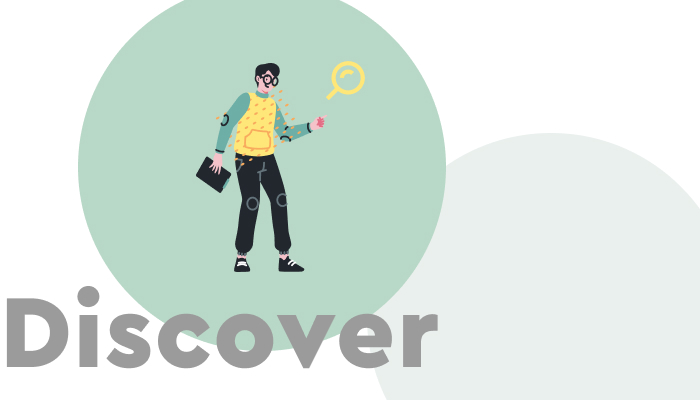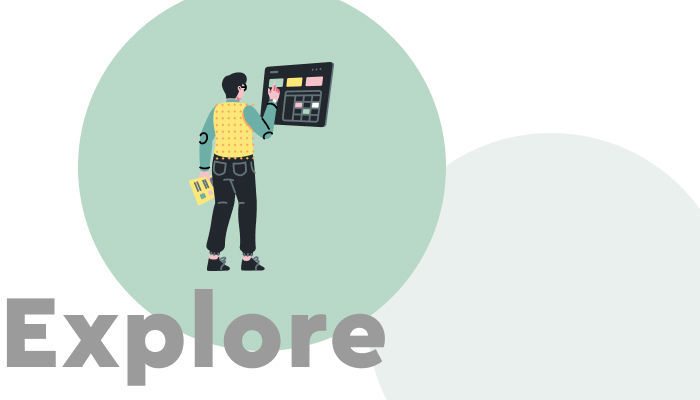Exploratory research (also called generative or discovery research) is used to discover the needs, behaviors, and goals of users of web and mobile applications that the designers and researchers didn't know before the study.
The primary purpose of exploratory research and exploratory data analysis is to gain a more profound, multidimensional understanding of end users — their problems, needs, behaviors, preferences, experiences, and emotions. It aids in developing a digital product.
Exploratory research allows you to understand the user and create a digital product that is better tailored to meet user goals and objectives in a more satisfying, enjoyable, and attractive way.
Exploratory research allows you to understand what need the product is supposed to satisfy and how and whose need it is supposed to fulfill.
In this sense, research is strategically vital and should be a permanent element in creating product strategies and implementation and development plans.
What is exploratory research? What types of UX research hide behind this name?
How to conduct exploratory research? When should it be used?
If you are curious about the answers to the above questions, be sure to read this article!
Exploratory research — what is it?
Exploratory research is most often recommended when business owners, UX/UI designers, and UX researchers notice that there are more unknowns than actual data, information, and knowledge that are relatively certain.

No single method or research technique is hidden behind the term exploratory research/exploratory study.
It's a collective name for any combination of methods and techniques that a research team (UX research) wants to use to deepen its understanding of product usage methods or end users' previously unknown needs. It allows researchers to generate hypotheses for further research. Moreover, even small sample sizes are enough for this type of research.
However, an exploratory study is not productively used to test preexisting theories but to discover them.
Exploratory research can be conducted at any stage of digital product development, but it's worth using it as early as possible.
This allows you to build a product focused on the end user's needs, capabilities, expectations, and experiences from the beginning.
Exploratory research allows you to discover, understand, explore, learn, and search for better solutions, fields, and areas with new opportunities.
In other words, it makes it possible to improve products and enhance the user experience.

It's also a source of inspiration and discoveries of new perspectives that help compete more effectively in the market, maintain position, and develop digital products.
The value of exploratory research
The broad problematic scope of this type of research (for example, expressed in the question: How do people learn to play instruments?) is an opportunity to understand the broader context.
By embedding the product in a grid of needs, values, goals, and expectations, the product becomes much more complex and of greater importance to the user.
Exploratory research is a tool capable of the following:
- Identifying and defining new research problems
- Establishing research priorities
- Formulating hypotheses
- Setting a long-term research strategy
The great advantage of exploratory research is the ability to pose any research question and find the most appropriate method to answer it.
Exploratory research is also helpful for generating new ideas (in terms of design, functions, research, and business).
It also provides a kind of map through which it is possible to:
- Gain more profound insights
- Prioritize work
- Justify decisions (design and business decisions)
- Empathize — to deeper understand users' emotions, positions, and conditions.
It allows UX/UI designers to better understand the problem they're trying to solve. It's also a fundamental basis for formulating design hypotheses that can be verified.
Thus, the design process is not haphazard but structured, purposeful, and more rational.

Exploratory research can also be a starting point for quantitative research, allowing you to test solutions and identify the most effective ones.
Starting from generally formulated problems (using questions such as: What? How? Where? Why? When? In what way?) and narrowing down aspects of the problems so you can reach more specific and concrete issues.
A common reason for using exploratory research is to discover a new field of innovation, a niche, or new areas into which a digital product can fit.
The main difference between evaluation and exploratory research is also reflected in this aspect.
Evaluation research (e.g., usability testing) determines the level of satisfaction of user needs by a digital product (expressed, for example, in ease of navigation).
Exploratory research creates new ideas by seeking answers to questions with a high level of generality.
The most commonly used research methods in exploratory research
Flexibility, which we have already mentioned, is expressed in the absence of rigid rules for selecting single or combined research methods and techniques.
The ability to be creative in the choice of methods is a significant advantage of exploratory research.
Examples of exploratory research
Exploratory research is usually conducted using the following:
- Individual in-depth interviews (IDIs)
- Focus groups
- Ethnographic observation methods
- Diary studies
- Contextual research
Individual in-depth interviews and focus groups are heavily formalized methods. They consist of conversations with respondents who are asked to express their opinions, comments, and observations regarding the digital product under study. These methods provide researchers with valuable qualitative data.
In focus group research, a researcher moderates their course. The interaction between respondents helps discover more problems and their popularity.
Ethnographic research allows you to observe application users in their natural environment, in a familiar context, which enables you to observe behaviors that are more natural, typical, and habitual.
Diary studies enable the systematic collection of data through a special questionnaire in which a respondent writes down all actions related to the study's subject.

Contextual research consists of conducting a structured interview and observing users and their behavior in their natural environment. Its goal is to discover how and under what conditions users use a digital product.
How to conduct exploratory research?
In the age of the pandemic and the growing popularity of research platforms, studies conducted in the remote formula are slowly becoming a norm. This also applies to exploratory research.
Exploratory research conducted remotely allows you to collect data in an equally reliable, accurate, and credible way and discover the behaviors, reactions, opinions, and attitudes of digital product users.
An appropriate approach to the techniques used in carrying out a study enables you to obtain valuable data.
When conducting exploratory research, it's necessary to ensure the following:
- Credibility and trust (toward research, researcher, and the subject of research)
- Appropriate, multi-channel building of a relationship with a respondent, thanks to which the study will be much more comfortable and understandable for them
- Multidimensionality of research, a combination of methods to guarantee a more profound, broader, and exhaustive study of the problem
- Proper preparation and guidance of research participants (gathering a representative sample of respondents)
- Familiarization of respondents with a tool that is used for communication and performing research tasks
In general, it's essential to appropriately prepare for conducting research by finding answers to the following questions:
- What is the primary purpose of the study?
- What are the most critical research questions?
- Which research methods will provide the most accurate and exhaustive answers?
- What kind of groups of respondents should be studied?
- Where and how to recruit research participants?
- With what tools should the research be conducted?
- What is the minimum and maximum time available for research?
Remember that the findings of exploratory research primarily serve the following purposes:
- Getting to know the customer groups — or to discover new, not previously considered
- Obtaining a broader picture of the market — the bigger picture
- Creating and testing new ideas
- Looking for opportunities
- Finding new opportunities, economic situations, niches, trends, cause and effect relationships, and tendencies.
Advantages of exploratory research:
- The directionless nature of exploratory research allows you to discover new areas worth developing that you might not have considered before.
- Exploratory studies can be performed with a small group of people and, therefore, are cheaper to organize.
- Exploratory research can help design subsequent studies because it lets you determine potentially helpful methodologies and provides useful data.
- When exploratory studies are carried out at the beginning of the development process, you can determine whether a given idea is worth investing in before your company makes bigger commitments.
- Exploratory research allows you to gain an in-depth understanding of the research topic and enables you to discover unexplored issues. This process also allows you to write more precise research questions.
Disadvantages of exploratory research:
- Exploratory research aims to provide initial results, not conclusive findings, and shouldn't be the sole basis for making decisions.
- Exploratory studies rely on qualitative research methods, and because of that, data analysis may be time-consuming.
- Even though a small sample size is useful and economical for quick studies, it carries a risk of not being a representative sample of a target group.
- Conducting exploratory research involves the risk of gathering data that may no longer be up-to-date and provide no value to the currently researched subject. Some sources may provide information that can be irrelevant to a given context upon further research.
Exploratory research. Summary
- The development of exploratory techniques has resulted in exploratory research being used to discover unknown needs, behaviors, and goals of users of web and mobile applications.
- The primary goal of exploratory research is a more profound, multidimensional understanding of end users — their problems, needs, behaviors, preferences, experiences, and emotions.
- Exploratory research allows you to understand not only what need the product is supposed to satisfy but also to pre-test how and for whom it is supposed to satisfy that need.
- It's often recommended when an organization measures or feels a deficit of certainty, reliable data, information, and knowledge, which can provide a decisive argument.
- Exploratory research includes a variety of research methods, and its distinguishing feature is flexibility.
- Exploratory research is the name used for any combination of methods (e.g., ethnographic UX research) and techniques, excluding UX usability testing, website usability testing, application usability testing, laboratory usability testing, remote usability testing, interface usability testing, and usability testing in general.
- Exploratory research's broad problem scope provides an opportunity to understand the wider context and embed the product in a grid of needs, values, goals, and expectations that is much more complex and of greater importance to the user.
- UX research and exploratory research are used to generate new ideas.
- They are a fundamental basis for formulating design hypotheses, which can then be subjected to verification.
- Evaluation research (e.g., usability testing) is used to determine the level of satisfaction of user needs provided by a digital product. Exploratory research creates new ideas by seeking answers to highly general questions.
- Qualitative UX research and UX research with users, including exploratory research, are often conducted through individual in-depth interviews, focus groups, ethnographic observation methods, diary studies, and contextual research.
- Like any research, exploratory research has advantages and disadvantages that you need to consider before starting the research process.







